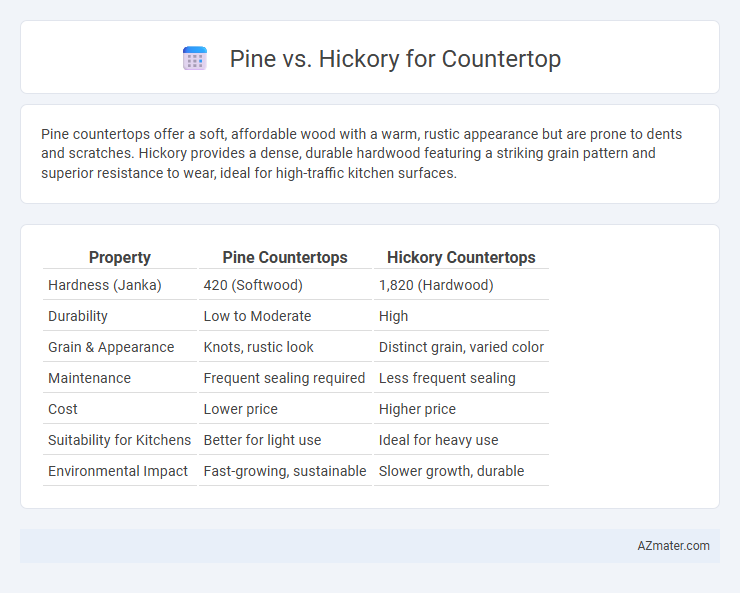Pine countertops offer a soft, affordable wood with a warm, rustic appearance but are prone to dents and scratches. Hickory provides a dense, durable hardwood featuring a striking grain pattern and superior resistance to wear, ideal for high-traffic kitchen surfaces.
Table of Comparison
| Property | Pine Countertops | Hickory Countertops |
|---|---|---|
| Hardness (Janka) | 420 (Softwood) | 1,820 (Hardwood) |
| Durability | Low to Moderate | High |
| Grain & Appearance | Knots, rustic look | Distinct grain, varied color |
| Maintenance | Frequent sealing required | Less frequent sealing |
| Cost | Lower price | Higher price |
| Suitability for Kitchens | Better for light use | Ideal for heavy use |
| Environmental Impact | Fast-growing, sustainable | Slower growth, durable |
Introduction to Pine and Hickory Countertops
Pine countertops offer a softwood option characterized by a warm, rustic appearance with distinctive knots and a lighter color palette, ideal for casual or farmhouse-style kitchens. Hickory countertops, made from a dense hardwood, provide exceptional durability and strength, featuring contrasting grain patterns that add a striking, natural aesthetic to high-traffic kitchen environments. Both materials vary in hardness and maintenance requirements, with hickory being more resistant to dents and scratches compared to the softer, more easily marked pine.
Appearance: Grain Patterns and Color
Pine countertops feature a soft, pale yellow to light brown color with prominent knots and a straight, uniform grain pattern that adds a rustic charm. Hickory displays a richer color range from creamy white to deep reddish-brown with pronounced grain patterns and natural variations that create a bold, textured look. The choice between pine and hickory depends on whether a softer, more subtle rustic aesthetic or a striking, dynamic grain appearance is desired for the countertop.
Durability and Hardness Comparison
Hickory countertops exhibit exceptional durability and hardness, ranking around 1,820 on the Janka hardness scale, making them highly resistant to dents and scratches. Pine countertops, with a significantly lower Janka hardness of approximately 380, are softer and more prone to dents, making them better suited for low-traffic areas. For kitchen surfaces requiring robust wear resistance, hickory offers superior longevity compared to pine.
Maintenance and Care Requirements
Pine countertops require regular sealing and are more prone to dents and scratches, demanding frequent maintenance to preserve their appearance. Hickory countertops offer greater durability and resistance to wear, needing less frequent sealing and simpler upkeep over time. Both woods benefit from prompt cleaning of spills and avoiding excessive moisture to maintain longevity.
Cost Analysis: Pine vs Hickory
Pine countertops generally cost between $20 to $30 per square foot, making them a budget-friendly option compared to hickory, which ranges from $40 to $60 per square foot due to its durability and hardness. Pine's softer nature means it may require more maintenance and refinishing over time, potentially increasing overall expenses. Hickory's higher upfront cost is balanced by its long-lasting strength and resistance to dents, offering better value for high-traffic kitchen surfaces.
Suitability for Kitchen and Bathroom Use
Pine countertops offer a warm, rustic aesthetic ideal for low-traffic kitchen and bathroom areas but are prone to dents and scratches due to their softness. Hickory, known for its exceptional hardness and durability, withstands heavy kitchen use and resists moisture and staining, making it more suitable for high-traffic kitchen countertops and bathroom vanities. Both woods require proper sealing to protect against water damage and maintain longevity in wet environments.
Environmental Impact and Sustainability
Pine countertops are sourced from fast-growing softwood trees, making them a more renewable option compared to hickory, which comes from slower-growing hardwood species. Hickory's density and durability often result in a longer lifespan, reducing the need for frequent replacement and minimizing waste over time. Choosing responsibly harvested pine or FSC-certified hickory can enhance sustainability and reduce the environmental footprint associated with countertop materials.
Pros and Cons of Pine Countertops
Pine countertops offer affordability and a warm, rustic charm with their soft grain and light color, making them ideal for cozy, country-style kitchens. They are easy to work with for DIY projects but tend to scratch, dent, and stain more easily compared to harder woods like hickory, requiring regular sealing and maintenance. Pine's softer nature makes it less durable and more prone to wear over time, which limits its longevity in high-traffic kitchen environments compared to the dense, shock-resistant hickory.
Pros and Cons of Hickory Countertops
Hickory countertops offer exceptional durability and resistance to dents and scratches, making them ideal for high-traffic kitchen areas, while their rich grain patterns provide a warm, rustic aesthetic that enhances farmhouse and traditional designs. However, hickory's hardness can make cutting and chopping directly on its surface challenging, potentially dulling knives faster than softer woods like pine. The cost of hickory countertops is typically higher due to its density and strength, and its tendency to darken over time requires regular maintenance to preserve its natural appearance.
Which Wood is Best for Your Countertop?
Hickory is often preferred for countertops due to its exceptional hardness, durability, and resistance to dents and scratches, making it ideal for high-traffic kitchen surfaces. Pine offers a softer, more affordable option with a warm, rustic aesthetic but requires more maintenance and is prone to dents and scratches. Choosing between pine and hickory depends on balancing your budget and desired durability with the aesthetic appeal and longevity needed for your countertop.

Infographic: Pine vs Hickory for Countertop
 azmater.com
azmater.com